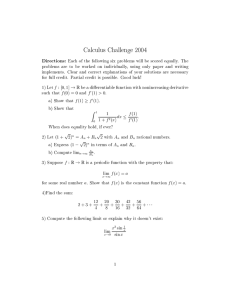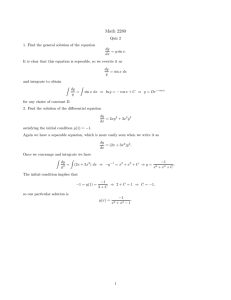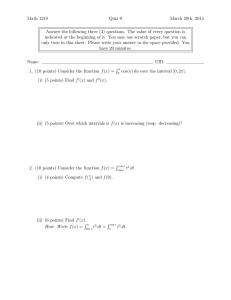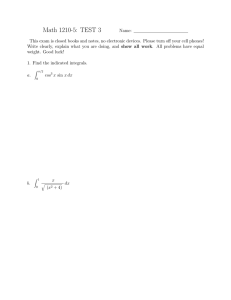Question 1: Z (1). Compute (3x
advertisement
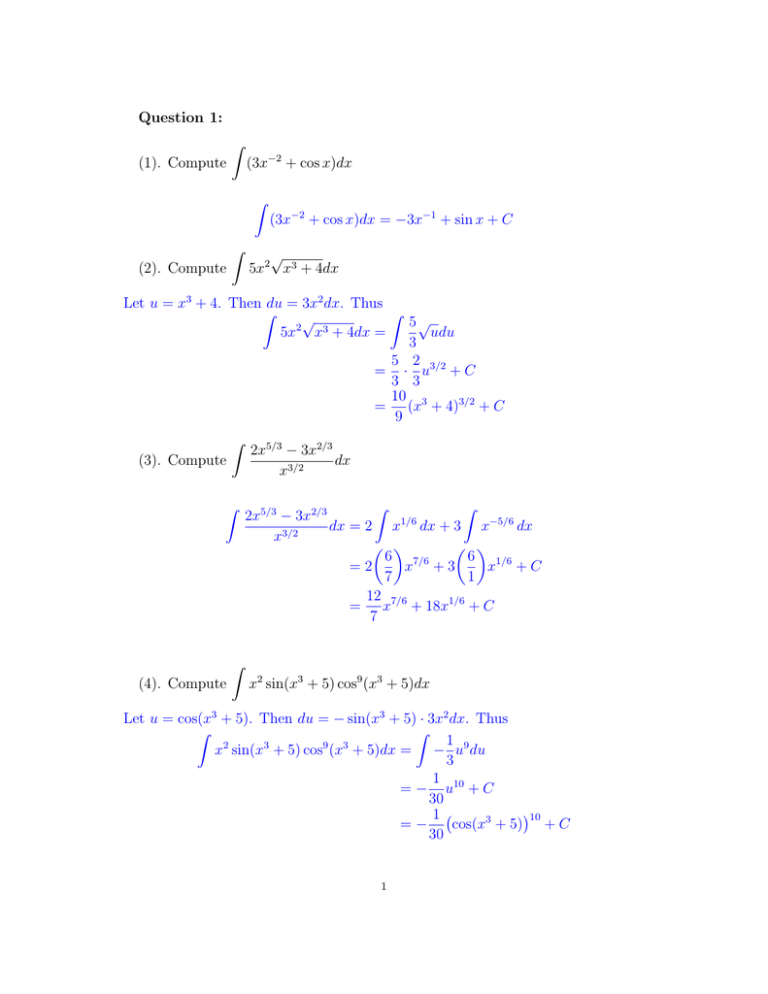
Question 1: Z (1). Compute (3x−2 + cos x)dx Z Z (2). Compute (3x−2 + cos x)dx = −3x−1 + sin x + C √ 5x2 x3 + 4dx Let u = x3 + 4. Then du = 3x2 dx. Thus Z Z √ 5√ 2 3 udu 5x x + 4dx = 3 5 2 = · u3/2 + C 3 3 10 3 = (x + 4)3/2 + C 9 Z (3). Compute Z Z (4). Compute 2x5/3 − 3x2/3 dx x3/2 Z Z 2x5/3 − 3x2/3 1/6 dx = 2 x dx + 3 x−5/6 dx x3/2 6 7/6 6 1/6 =2 x +3 x +C 7 1 12 = x7/6 + 18x1/6 + C 7 x2 sin(x3 + 5) cos9 (x3 + 5)dx Let u = cos(x3 + 5). Then du = − sin(x3 + 5) · 3x2 dx. Thus Z Z 1 2 3 9 3 x sin(x + 5) cos (x + 5)dx = − u9 du 3 1 = − u10 + C 30 10 1 =− cos(x3 + 5) + C 30 1 2 Question 2: Z (1). Let F (x) = x 2 t + 3t + 5 dt. Find F 0 (x). t3 + 1 1 F 0 (x) = Z (2). Let F (x) = x2 + 3x + 5 x3 + 1 π sin tdt. Find F 0 (x). x Z F (x) = − x sin tdt π Thus F 0 (x) = − sin(x) Z (3). Let F (x) = x4 +16x2 (t2 + t)dt. Find F 0 (x). 2 F 0 (x) = [(x4 + 16x2 )2 + (x4 + 16x2 )] · (4x3 + 32x) Z 1 x 1+t dt. (4). Compute lim x→0 x 0 2 − t R x 1+t Let F (x) = 0 2−t dt. Then R x 1+t R0 Z dt − 0 1 x 1+t 0 2−t dt = lim lim x→0 x→0 x 0 2 − t x−0 F (x) − F (0) = lim x→0 x−0 0 = F (0). Since F 0 (x) = 1+x , 2−x we have F 0 (0) = 1/2. 1+t dt 2−t 3 Question 3: Z Approximate the definite integral 1 (4x3 + 1)dx by finding the Riemann sum for 0 this integral using partition x0 = 0, x1 = 1/3, x2 = 2/3, x3 = 1 and right endpoints. Let f (x) = 4x3 + 1. Then R3 = f (x1 ) · (x1 − x0 ) + f (x2 ) · (x2 − x1 ) + f (x3 ) · (x3 − x2 ) 3 3 3 1 1 2 1 3 1 = 4 +1 · + 4 +1 · + 4 +1 · 3 3 3 3 3 3 25 = 9 4 Question 4: Solve the following differential equation: r dy x = ; y = 4 at x = 1 dx y By separating the variables, we have Z Z √ √ ydy = xdx Thus 2 3/2 2 3/2 y = x +C 3 3 Since y = 4 at x = 1, we have C= 2/3 3/2 Therefore, y = x + 7 . 2 3/2 2 3/2 14 ·4 − ·1 = 3 3 3 5 Question 5: A rectangle has two corners on the x-axis and the other two on the parabola by y = 9 − x2 , with y ≥ 0 (shown in the following figure). What are the dimensions of the rectangle of this type with maximum area? (Hint: let (x, y) denote the coordinate of the upper left corner. Then what is the area of the rectangle in terms of x and y? What is the relation between x and y?) Let the coordinate of the upper right corner of the rectangel be (x, y). Then the length and width of the rectangle is 2x and y, respectively. Therefore the area of the rectangel is A = 2x · y. On the other hand, (x, y) is on the parabola y = 9 − x2 . Thus we have A = 2x · (9 − x2 ) = 18x − 2x3 Then and dA = 18 − 6x2 dx d2 A = −12x < 0, for x > 0 dx2 √ Therefore, at x = √ 3, the rectangle achieves its maximum area. In other words, when the length is 2 3 and the width is 6, the rectangle has maximum area.


